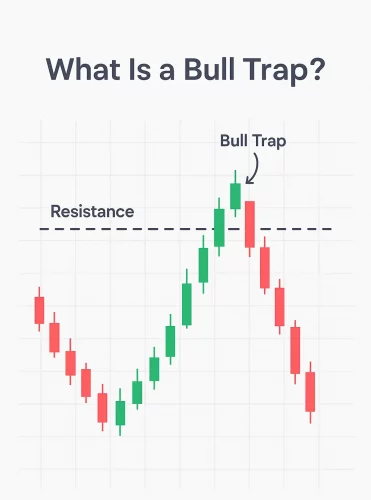What Is a Bull Trap? Pattern, Psychology & How to Avoid It
Navigating financial markets can be challenging, especially when deceptive patterns like bull traps can lead to significant losses. As a trader or investor, understanding what a bull trap is, why it happens, and how to avoid it is crucial for protecting your capital and making informed decisions. In this comprehensive guide, you’ll gain a deep understanding of bull traps across different markets, including stocks and crypto, and learn practical strategies to identify and avoid them.

What Is a Bull Trap?
A bull trap is a deceptive market signal that occurs when the price of an asset, such as a stock or cryptocurrency, appears to reverse from a downtrend and starts moving upwards, suggesting the beginning of a bullish trend. However, this upward movement is short-lived, and the price quickly reverses back into its original downtrend, trapping traders who bought into the asset expecting further gains. This phenomenon is particularly common in bear markets or during periods of high volatility, where false signals can mislead investors.
In the stock market, a bull trap typically involves the price breaking above a key resistance level a price point where selling pressure has historically prevented further rises. When the price breaks above this level, it may seem like a strong buying opportunity, attracting bullish investors. However, if the price fails to sustain above this level and falls back below it, those who bought at the breakout point are left with losses, hence the term “trap”.
Similarly, in the cryptocurrency market, bull traps can occur when the price of a crypto asset surges above a resistance level but then quickly reverses, catching traders off guard. The high volatility of cryptocurrencies makes them particularly susceptible to such traps, as price movements can be driven by speculative trading rather than fundamental strength.
Understanding bull traps is essential for you as a trader, as it helps you avoid falling into these deceptive patterns and making costly mistakes. By recognizing the signs of a potential bull trap, you can better protect your investments and make more informed decisions.
Why Do Bull Traps Happen?
Bull traps are not just technical phenomena; they are deeply rooted in the psychology of market participants. Understanding why bull traps occur requires delving into the behavioral aspects that drive traders’ decisions.
One of the primary reasons bull traps happen is due to herd mentality. In financial markets, traders often follow the actions of others, especially when they see a stock price rising. This behavior is amplified by the fear of missing out (FOMO), where you might buy into a stock because you believe the upward trend will continue, not wanting to miss potential profits. This collective buying can temporarily push the price higher, creating the illusion of a genuine reversal Strike.
Another psychological factor is confirmation bias. You may have a preconceived notion that a stock is about to reverse its downtrend, and when you see the price breaking above a resistance level, you interpret this as confirmation of your belief, ignoring other indicators that might suggest otherwise. This bias can lead you to enter positions prematurely, without waiting for further confirmation.
Emotional trading also plays a significant role. Greed, the desire to make quick profits, can cloud your judgment, prompting you to buy into a stock without thorough analysis. The excitement of a potential upward move can override rational decision-making, leading to impulsive trades that end in losses when the trap is sprung.
Moreover, the lack of confirmation in trading strategies can contribute to bull traps. Experienced traders often wait for confirming signals, such as increased trading volume or specific candlestick patterns, before entering a position. However, as a novice trader, you might act solely on the breakout itself, without seeking additional validation, making you more vulnerable to traps.
Additionally, market manipulation by larger players, such as institutional investors or market makers, can create conditions for bull traps. These entities might buy large quantities of a stock to push the price above a resistance level, triggering stop-loss orders from short sellers or attracting new buyers, only to sell off their positions, causing the price to plummet.
Finally, misinterpretation of technical analysis can lead to bull traps. You might misread chart patterns, indicators, or signals, believing a reversal is imminent when, in fact, the market is merely testing a resistance level before continuing its downtrend.
Bull Trap Pattern: How to Identify One
Identifying a bull trap is crucial for you to avoid falling into these deceptive patterns. While no method is foolproof, there are several technical indicators and chart patterns that can help you recognize when a bull trap might be forming.
| Indicator | Description | How It Helps Identify a Bull Trap |
|---|---|---|
| Breakout without Confirmation | A price breakout above resistance without supporting indicators. | Low volume or lack of bullish candlesticks suggests a false breakout. |
| Bearish Candlestick Patterns | Patterns like shooting star or bearish engulfing after a breakout. | Indicates weakening momentum and potential reversal. |
| Volume Divergence | Low trading volume during a breakout. | Suggests lack of buyer conviction, increasing trap likelihood. |
| Price Reversal | Price falls back below resistance after a breakout. | Confirms the breakout was false, trapping buyers. |
| Indicator Divergence | Divergence between price and indicators like RSI or MACD. | Price makes a new high, but indicators don’t, signaling weakness. |
| Footprint Charts | Detailed volume and price interaction analysis. | Shows if breakout is driven by genuine buying or stop-loss triggers. |
| Market Psychology/News | Sudden price surges without fundamental backing. | Indicates speculative moves, common in crypto bull traps. |
- Breakout without Confirmation: One of the primary signs of a potential bull trap is a price breakout above a resistance level that lacks confirmation from other indicators. For example, if the breakout is accompanied by low trading volume, it may indicate that there isn’t enough buying interest to sustain the upward movement. Typically, a genuine breakout should be supported by higher than average volume.
- Bearish Candlestick Patterns: After a price breaks above resistance, the formation of bearish candlestick patterns, such as the ‘shooting star’ or ‘bearish engulfing’, can signal that the upward momentum is weakening. These patterns suggest that sellers are starting to dominate, which could lead to a reversal.
- Volume Divergence: Paying attention to volume is key. If the price breaks above resistance but the volume is lower than usual, it might indicate a lack of conviction among buyers. In contrast, a genuine breakout should see an increase in volume, reflecting strong buying interest.
- Price Reversal: A quick reversal back below the resistance level after a breakout is a clear sign of a bull trap. You should be cautious if the price fails to hold above the breakout level and starts to decline shortly after.
- Indicator Divergence: Technical indicators like the Relative Strength Index (RSI), Moving Average Convergence Divergence (MACD), or Stochastic Oscillator can show divergence from the price action. For instance, if the price makes a new high but the RSI does not, it could indicate weakening momentum and a potential reversal.
- Footprint Charts: For more advanced traders, footprint charts can provide detailed insights into the buying and selling dynamics during a breakout. These charts show the volume and price levels at which trades are executed, helping you identify whether there is genuine buying interest or if the breakout is driven by stop-loss orders being triggered.
- Market Psychology and News: Especially in volatile markets like cryptocurrencies, it’s important to consider the broader market context. Sudden price surges without any fundamental news or developments might be indicative of a bull trap, as they could be driven by speculative trading rather than genuine market strength.
Bull Trap vs Bear Trap: What’s the Difference?
While bull traps and bear traps are both deceptive market signals, they occur in opposite scenarios and affect different types of traders.
| Aspect | Bull Trap | Bear Trap |
|---|---|---|
| Definition | Price breaks above resistance, suggesting an uptrend, but reverses down. | Price falls below support, suggesting a downtrend, but reverses up. |
| Trapped Traders | Bullish traders buying at the breakout. | Bearish traders selling or shorting at the breakdown. |
| Market Condition | Common in bear markets or downtrends. | Common in bull markets or uptrends. |
| Outcome | Downtrend resumes, causing losses for buyers. | Uptrend resumes, causing losses for sellers. |
A bull trap happens when the price of an asset breaks above a key resistance level, giving the impression that a downtrend is reversing into an uptrend. This lures bullish traders into buying the asset, expecting further price increases. However, the price soon reverses and continues its downtrend, trapping these buyers in losing positions.
On the other hand, a bear trap occurs when the price of an asset falls below a key support level, suggesting that an uptrend is reversing into a downtrend. This prompts bearish traders to sell or short the asset, anticipating further price decreases. But instead, the price quickly recovers and continues its uptrend, trapping these sellers as the price rises against their positions.
Bull Trap Example (Real Market Chart)
To illustrate a real-world example of a bull trap, let’s examine the S&P 500 futures market on July 16, 2024. On that day, the S&P 500 futures reached a historical high, breaking above the previous peak, which was around 5,500. This breakout was accompanied by an abnormal spike in buying volume, as indicated by the Delta indicator, suggesting strong buying interest.
However, despite the initial surge, the price failed to sustain above this level. The candle closed below the bright green cluster, which typically represents strong buying pressure. If this cluster had represented genuine buying strength, the price would have continued to rise. Instead, it started a gradual decline that accelerated over the following days.
This scenario is a classic example of a bull trap. Traders who bought into the breakout, expecting the upward trend to continue, were trapped as the price reversed and began to fall. The failure of the price to hold above the breakout level, despite the initial buying volume, indicated that the bulls did not have enough strength to sustain the rally, leading to a resumption of the downtrend.
For you as a trader, this example highlights the importance of waiting for confirmation after a breakout. In this case, the price closing below the breakout level and the subsequent decline confirmed that the breakout was false, allowing you to avoid the trap if you had not yet entered a position.
How Long Does a Bull Trap Last & What Happens After?
The duration of a bull trap can vary depending on the time frame of the chart being analyzed. On shorter time frames, such as 1-hour or 4-hour charts, a bull trap might last only a few candlesticks, which could be a matter of hours. On daily charts, it might last a few days, while on weekly charts, it could extend over several weeks.
After a bull trap occurs, the price typically resumes its original downtrend. The reversal can be sharp and swift, often catching traders off guard. As the price falls, trapped bulls who bought during the false breakout may panic and sell their positions, adding to the selling pressure and accelerating the downward movement. This can lead to a more significant decline than the initial downtrend, as the market absorbs the liquidity from the trapped traders.
In some cases, the price might test lower support levels or even break below previous lows, indicating a continuation of the bearish trend. You, as a trader, can use this information to your advantage by entering short positions after the reversal, potentially profiting from the subsequent decline.
How to Avoid Bull Traps (Checklist for Traders)
To avoid falling into bull traps, you can follow this checklist:
| Strategy | Description |
|---|---|
| Wait for Confirmation | Wait for price to close above resistance on a higher time frame or for multiple candlesticks to confirm the breakout. |
| Check Trading Volume | Ensure breakout has higher than average volume. |
| Use Technical Indicators | Monitor RSI, MACD, or Stochastic for divergence. |
| Look for Bearish Candlestick Patterns | Watch for patterns like shooting stars or bearish engulfing after a breakout. |
| Consider the Overall Trend | Be cautious of breakouts in strong downtrends. |
| Set Stop-Loss Orders | Place stop-loss orders below the breakout level. |
| Practice Patience | Avoid chasing breakouts without confirmation. |
Wait for Confirmation: Do not enter a long position immediately after a breakout above resistance. Wait for confirmation, such as the price closing above the resistance on a higher time frame or waiting for a few candlesticks to ensure the breakout is genuine.
Check Trading Volume: Ensure that the breakout is accompanied by higher than average trading volume. Low volume breakouts are more likely to be false signals.
Use Technical Indicators: Monitor indicators like RSI, MACD, or Stochastic for divergence between price and momentum. If the price makes a new high but the indicators do not, it might indicate weakening momentum.
Look for Bearish Candlestick Patterns: After a breakout, watch for bearish candlestick patterns, such as shooting stars or bearish engulfing patterns, which can signal a potential reversal.
Consider the Overall Trend: Be aware of the broader market trend. If the market is in a strong downtrend, be cautious of breakouts above resistance, as they might be bull traps.
Set Stop-Loss Orders: Always set a stop-loss order when entering a position to limit potential losses if the price reverses IG International.
Practice Patience: Avoid chasing breakouts. It’s better to miss a trade than to enter a position that turns out to be a trap.
Bull Traps in Crypto vs Stocks
While bull traps can occur in both cryptocurrency and stock markets, there are distinct differences in how they manifest and the factors that contribute to them, due to the unique characteristics of each market.
| Strategy | Description |
|---|---|
| Wait for Confirmation | Wait for price to close above resistance on a higher time frame or for multiple candlesticks to confirm the breakout. |
| Check Trading Volume | Ensure breakout has higher than average volume. |
| Use Technical Indicators | Monitor RSI, MACD, or Stochastic for divergence. |
| Look for Bearish Candlestick Patterns | Watch for patterns like shooting stars or bearish engulfing after a breakout. |
| Consider the Overall Trend | Be cautious of breakouts in strong downtrends. |
| Set Stop-Loss Orders | Place stop-loss orders below the breakout level. |
| Practice Patience | Avoid chasing breakouts without confirmation. |
Cryptocurrency Markets
High Volatility: Crypto markets are known for their extreme volatility, which can lead to rapid price movements that might result in bull traps. A sudden surge in price can attract buyers, only for the price to reverse quickly, trapping those who entered at the high.
24/7 Trading: Unlike stock markets, crypto markets operate 24/7, which means that news and events can impact prices at any time, leading to unexpected price movements that can set up bull traps.
Influence of Social Media and News: In crypto, social media platforms and news outlets can have a significant impact on price movements. A positive tweet from an influential figure or a false rumor can cause a temporary price surge, which might turn out to be a bull trap when the news is debunked or the hype dies down.
Lower Liquidity: Some crypto assets, especially smaller altcoins, have lower liquidity compared to major stocks, which can lead to larger price swings and more pronounced bull traps.
Stock Markets
Fundamental Analysis: In stock markets, bull traps might be more closely tied to fundamental factors such as earnings reports, economic indicators, or company news. A stock might experience a price surge on positive news, but if the news doesn’t hold up or is overshadowed by other factors, the price might reverse, creating a bull trap.
Market Hours: Stock markets have specific trading hours, which means that price movements are more predictable in terms of when news might impact the market. However, after-hours trading can still lead to bull traps if significant news is released outside of regular trading hours.
Regulation and Oversight: Stock markets are more regulated, which can provide more stability and reduce the likelihood of extreme price manipulations that might lead to bull traps, although they are not immune to them.
Higher Liquidity: Major stocks generally have higher liquidity, which can make price movements less erratic, but bull traps can still occur, especially in less liquid stocks or during periods of high market volatility.
In summary, while the concept of a bull trap is the same in both markets, the frequency, causes, and intensity can differ due to the structural differences between cryptocurrency and stock markets. As a trader, you need to be aware of these differences and adjust your strategies accordingly to avoid falling into bull traps.

